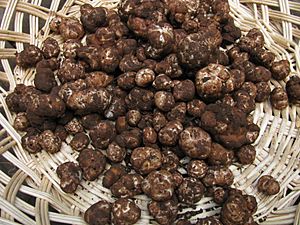Tuber gibbosum facts for kids
Quick facts for kids Tuber gibbosum |
|
|---|---|
 |
|
| Scientific classification | |
| Genus: |
Tuber
|
| Species: |
gibbosum
|
| Tuber gibbosum | |
|---|---|
| Mycological characteristics | |
| glebal hymenium | |
| hymenium attachment is not applicable | |
| lacks a stipe | |
| spore print is blackish-brown to brown | |
| ecology is mycorrhizal | |
| edibility: choice | |
Tuber gibbosum is a special type of truffle, which is a kind of mushroom that grows underground. It belongs to the Tuber family. You can find this truffle in the Pacific Northwest part of the United States. It grows closely with Douglas-fir trees, sharing nutrients in a partnership called an ectomycorrhizal association. People collect these truffles to eat from October all the way through March.
Contents
Understanding Tuber gibbosum
How Tuber gibbosum Got Its Name
The first person to describe Tuber gibbosum was an American scientist named Harvey Wilson Harkness in 1899. The second part of its name, gibbosum, comes from a Latin word meaning "humped." This name was chosen because bigger truffles of this type often have bumpy, uneven shapes.
Family Tree of Tuber Truffles
|
|||||||||||||||||||||||||||||||||||||||||||||
| Phylogeny of Tuber species in the Gibbosum clade, based on ribosomal DNA sequences. |
Scientists use something called a cladogram to show how different species are related, like a family tree. Tuber gibbosum is part of a group of Tuber truffles called the gibbosum clade. This means it shares a common ancestor with other truffles in this group.
For example, the cladogram shows that Tuber gibbosum is very closely related to Tuber bellisporum. They are also related to other truffles like Tuber castellanoi and Tuber oregonense. This helps scientists understand how different truffles evolved.
Similar Truffles
Tuber gibbosum looks a lot like another truffle called T. oregonense. Both of these truffles grow in the same places, usually under Douglas fir trees.
Is Tuber gibbosum Edible?
Yes, Tuber gibbosum is safe to eat! You can cook with it in similar ways to how people use European truffles. It's often used to add a special, earthy flavor to different dishes.


